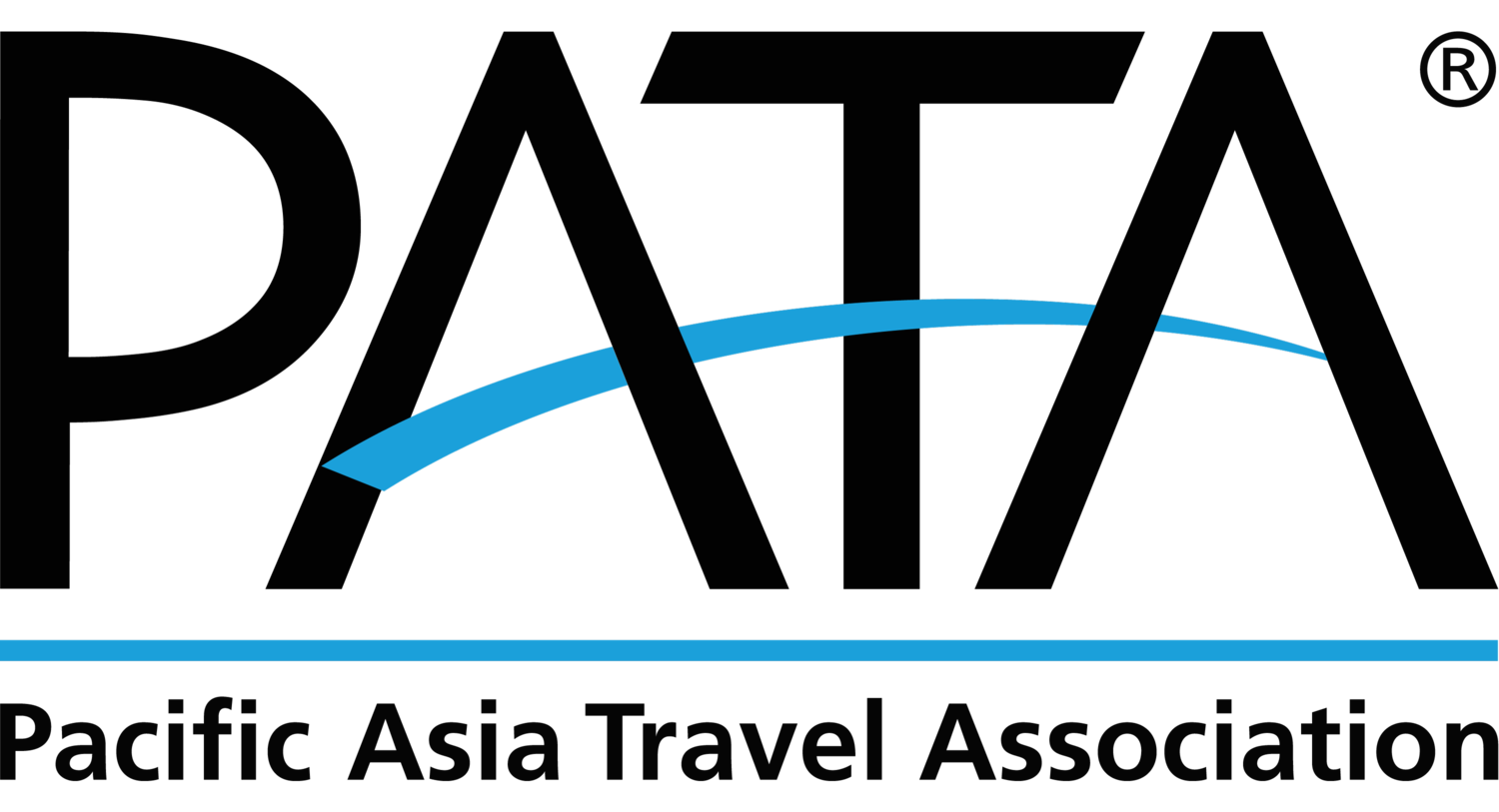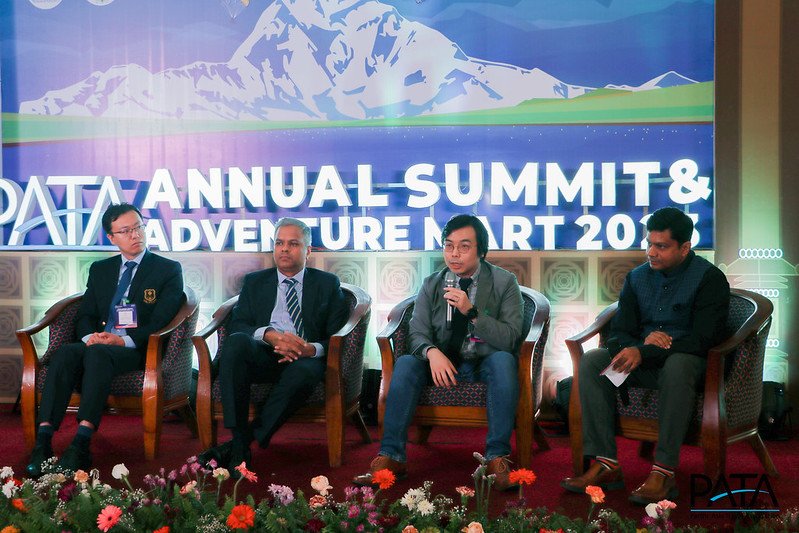Sustainability Through Tourism: It’s a Wrap for PATA Annual Summit & Adventure Mart 2023!
The PATA Annual Summit and Adventure Travel Mart 2023, hosted by the Nepal Tourism Board in Pokhara, welcomed 222 delegates from 115 organisations and 22 destinations.
The three-day event featured 11 main stage sessions, a two-day travel mart, a half-day Youth Symposium, a one-day destination tour, and half-day Government Meeting and Government Bilateral Meeting that provided our Government members with safe space for open dialogues and transparent exchange on tackling post-pandemic and sustainability challenges and best practices.
Take a sneak peek at the key takeaways from PAS 2023 below.
Andrew Staples, Regional Head, (APAC), Policy & Insights, Economist Impact
“The Briefing: Global Outlook”
The outlook for the global economy is expected to grow by 2.2%, with Asia delivering 70% of all global economic growth - India, China, Philippines, and Japan leading the way. Though not out of the woods yet, inflation has peaked and will slowly come down in the second half of 2023 with many currencies in the region strengthening. The global economy, though not at its best, is picking up and the outlook has upgraded - thanks to the reopening of China.
L/R: Dr. Anyu Liu, Assistant Professor, School of Hotel and Tourism Management, The Hong Kong Polytechnic University; Mayur (Mac) Patel, Head of Asia, OAG; Herbert Yum, Research Manager, Euromonitor International; Sridhar Keppurengan, Head of Cross Border Payments India & South Asia, VISA
“Insights into the Future of Tourism in the Asia Pacific”
By 2024, most key market arrivals (US, China, Thailand, Australia) will reach 2019 levels; Asia Pacific total arrivals will reach 800M by 2025 - a 115.5% recovery rate. By March 2024, global air capacity is expected to fully recover, with 7/10 of the busiest international airports located in the Asia Pacific.
Emerging and developing Asian economies are currently seeing a 5.3% GDP growth with 3.9% inflation compared to 6.9% globally; travellers are willing to spend on travel, but in new mindsets: being mindful in where they spend, more willing to spend when the process is made easy and one-stop, and keen on recurring spendings. Though there are less people travelling, more spending has been recorded - India is now seeing huge increases in both inbound and outbound spending.
L/R: Dr. Dhananjay Regmi, CEO, Nepal Tourism Board (NTB); Dr. Abdulla Mausoom, Minister, Ministry of Tourism, Maldives; Raki Phillips, CEO, Ras Al Khaimah Tourism Development Authority; Florian Sengstschmid, CEO, Azerbaijan Tourism Board
“The Challenges and Opportunities for a Responsible Tourism Industry”
Destinations are now shifting toward responsibly approaching tourism rather than just sustainably - having a comprehensive roadmap to incorporate sustainability into all new developments, tapping into regional and community tourism with greatest respect to their distinct differences, and to be mindful about the impacts that tourism might bring.
On the rising popularity of “all-inclusive”, the simplest solution is to train and support the smaller local businesses to also become “all-inclusive” in their own distinct way to capture the increased interest in travellers looking for an “experience”. On the other hand, this trend is not entirely negative as destinations ultimately need to attract visitors to stimulate development.
L/R: Peter Semone, Chair, PATA; Upaul Majumdar, Head of Practice Tourism, Dolma Consulting; Rosabella Ong, Principal Client Partner (SEA), Tripadvisor; Lisa Choegyal, Sustainable tourism specialist and Director, Tiger Mountain Pokhara Lodge
“How to Drive Higher Value Tourism”
Do higher-value travellers equal luxury seekers? Despite Tripadvisor seeing interest in higher-spending experiences, they are not necessarily looking for the literal “five-star” experience. Rather, they are looking for the “high quality” that will improve their overall experience.
The master plan to drive higher tourism is ultimately for the private sector to package the same products differently to fit in what the public sector has envisioned for the direction of development. Travellers are now showing a greater tendency to book directly, giving suppliers more opportunities to market their “repackaged products” and explain why they do what they do, for instance, why sustainability comes with an extra price.
Prof. Dr. Wolfgang Georg Arlt, CEO, China Outbound Tourism Research Institute (COTRI)
“The Return of Chinese Travellers”
Since its reopening, China’s outbound market in 2023Q1 brought HKSAR +38,993% arrivals, Thailand +3,649%, and Singapore +912%. In the post-pandemic era, this market is seeing an increase in independent travel, the search for a sense of inclusivity and adventures, and basing their destination decisions on interests over the destination itself. Chinese are looking for meaningful travel- products that are not the typical stereotyped sights and align the different interests between consumers and providers.
SanJeet, Director - DDP Publications Pvt Ltd
“The Opportunity of the Indian Market”
The Indian market is incredibly propitious- current 30M outbound travellers only make up 2% of India’s total population, airports are expected to double by 2025, and domestic travel is expected to exceed 2019’s 2.3B, just to name a few. To capture this blooming market, businesses have to establish a unique proposition that resonates with Indians, be flexible for last-minute changes, provide them reasons to share online, and be prepared to meet their high expectations for all-inclusive support.
Matt Gibson, CEO, UpThink
“How Can Artificial Intelligence (AI) Drive Tourism Business”
Next generation of travel planning and booking: voice interface (Siri) plus conversational abilities (ChatGPT). Using ChatGPT, you will be able to provide answers to consumers in a more timely manner, promote your business/ destination in your preferred style that aligns with your
Presented by: Binita S. Khadka, Senior External Relations Officer, Asian Development Bank (ADB); Raj Gyawali, Tourism Strategy and Promotion Expert, Asian Development Bank (ADB)
"Sustainable Tourism Interventions in Nepal"
Using the Sudurpashchim Province Tourism Master Plan and Kathmandu Valley Wastewater Management Project as two examples, the Asian Development Bank (ADB) showcased on-the-ground sustainable tourism initiatives, as well as how with careful planning and quality implementation, win-win solutions can be achieved for communities, heritage conservation and development.
John Bailey, Chief Operating Officer, GoCrisis
“Managing Crises and Challenges in the Post-pandemic World”
In the post-pandemic era, DMOs and organisations now are facing the same challenges but with fewer resources and a media “always-on” landscape where issues can quickly escalate if not well handled. It is well-known that timely communication is key, but the real questions to consider are: 1) Who should be leading the responses and communications? 2) How to ensure all stakeholders are aligned on your communications? 3) What are the available resources to facilitate the response? 4) Where should you be looking for support?
L/R: Nandini Lahe Thapa, Senior Director - PR and Publicity, NTB; Madubhani Perera, Director/Public Relations, Sri Lanka Tourism Promotion Bureau; Datuk Musa Hj. Yusof, Deputy Director General (Promotion), Tourism Malaysia; John Bailey, Chief Operating Officer, GoCrisis
“Managing Crises and Challenges in the Post-pandemic World”
From the experience of Nepal, Sri Lanka, and Malaysia, the keys to timely communication are 1) setting a team that operates 24/7, 2) managing the situation as a team, and 3) being prepared to talk about the seriousness even before the crisis happens.
From their experience, social media has been one of the most helpful tools during crises to help with communication, as it is readily available and highly accessible by all that might need to be connected- utilise the “always on” characteristic of media. With social media, it also provides transparency through its ability to enable two-way conversations. Above all these, it is essential that crisis managers instil confidence into stakeholders that what the team is doing and what the team is capable of are right for the situation.
L/R: Agnes Luz, Chief of Party, USAID Trade and Competitiveness Nepal; Lucky Chhetri, Founder & Chief Executive Director, 3 Sisters Adventure Trekking; Dr. Chuwit Mitrchob, Deputy Director-General, Designated Areas for Sustainable Tourism Administration; Pavnesh Kumar, Sustainability & Social Responsibility Programme Head, PATA
“Activating Partnerships with Communities for Sustainability”
A successful partnership should be inclusive- benefitting different stakeholders in the community and includes grassroot level stakeholders that are at the heart of the issue that needs to be addressed.
To discover what partnership truly works, a good analysis on the market and stakeholder is important, as well as keeping a record of delivering results. It is also crucial to keep in mind that a good partnership should not be a “one-side-provide-all” relationship; rather, expectations should be established to fully leverage the different dynamics among all stakeholders in the partnership.
L/R: Monayac Karki, CEO & Founder, Uptrendly; Matt Gibson, CEO, UpThink; Shradha Shrestha, Manager, Tourism Branding, Marketing & Promotion, NTB
“Working with Influencers on Social Media”
Influencers, who rather refer to themselves as content creators, are people who are passionate in a niche and have followers who trust them in that niche. For brands who are looking to leverage influencer marketing, it is important to reach out to those who can match your sponsorship to their brand seamlessly to make the collaboration more convincing.
To be connected with influencers, organisations can reach out to them when they are at the destination by following local hashtags; destinations can also create a fund programme or influencer application accessible for all local businesses so they can reach out to interested influencers anytime. One important thing to note is that content on Google and Youtube - where people instinctively look for information have longer shelf lives than any other social media, therefore, should not be overlooked in their potential for influencer marketing.
Some other happenings at the event include:
PATA Youth Symposium
Adventure Travel Mart
Government Meetings, PATA Executive Board Meetings, PATA Board Meetings, and PATA Chapter Congress
Spanning from May 30 to June 2, the event gathered leaders from the public and private sectors to convene on forging a sustainable path forward in the transformed area through digital innovations and valuable past learnings. Check out more event photos here >
Thank you to the event sponsors, partners, delegates, and buyers and sellers that made this event possible. See you all at our next event in Sarawak, Malaysia- PATA Destination Experience Forum & Mart!
The PATA Annual Summit and Adventure Travel Mart 2023 was generously hosted by the Nepal Tourism Board with support from Event Patron, the Pokhara Municipality; Local Partner, the Pokhara Tourism Council; Event Partners, the Asian Development Bank (ADB), Everest Bank Limited, Machhapuchhre Bank Limited, Nabil Bank and the Nepal Investment Bank; Event Tech Partners, Cvent and the Thailand Convention and Exhibition Bureau (TCEB); National Carrier, Nepal Airlines; Official Domestic Carriers, Buddha Air and Yeti Airlines, and Youth Sponsors, the Global Peace Foundation, the Guam Visitors Bureau, and the PATA Thailand Chapter.















